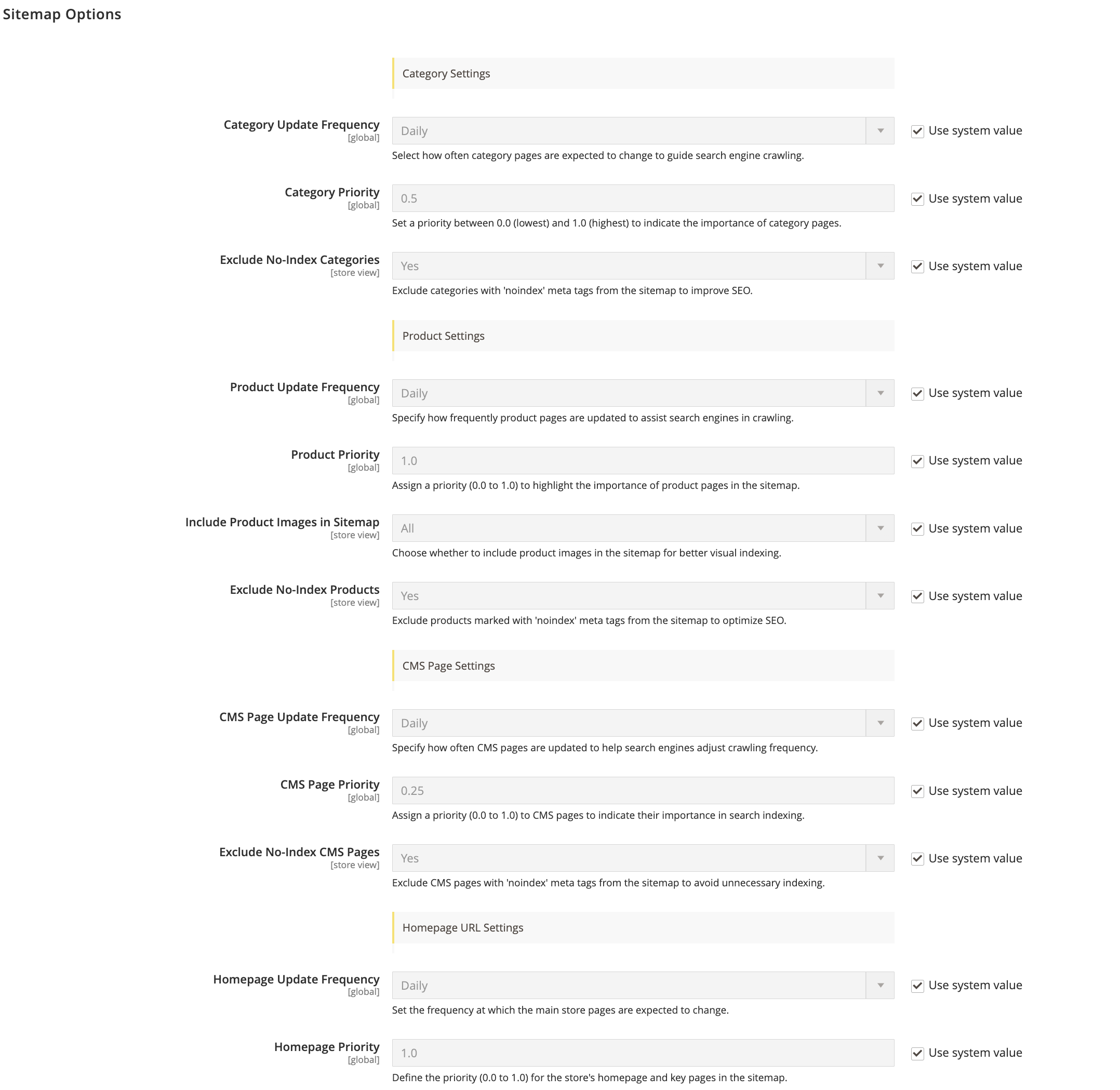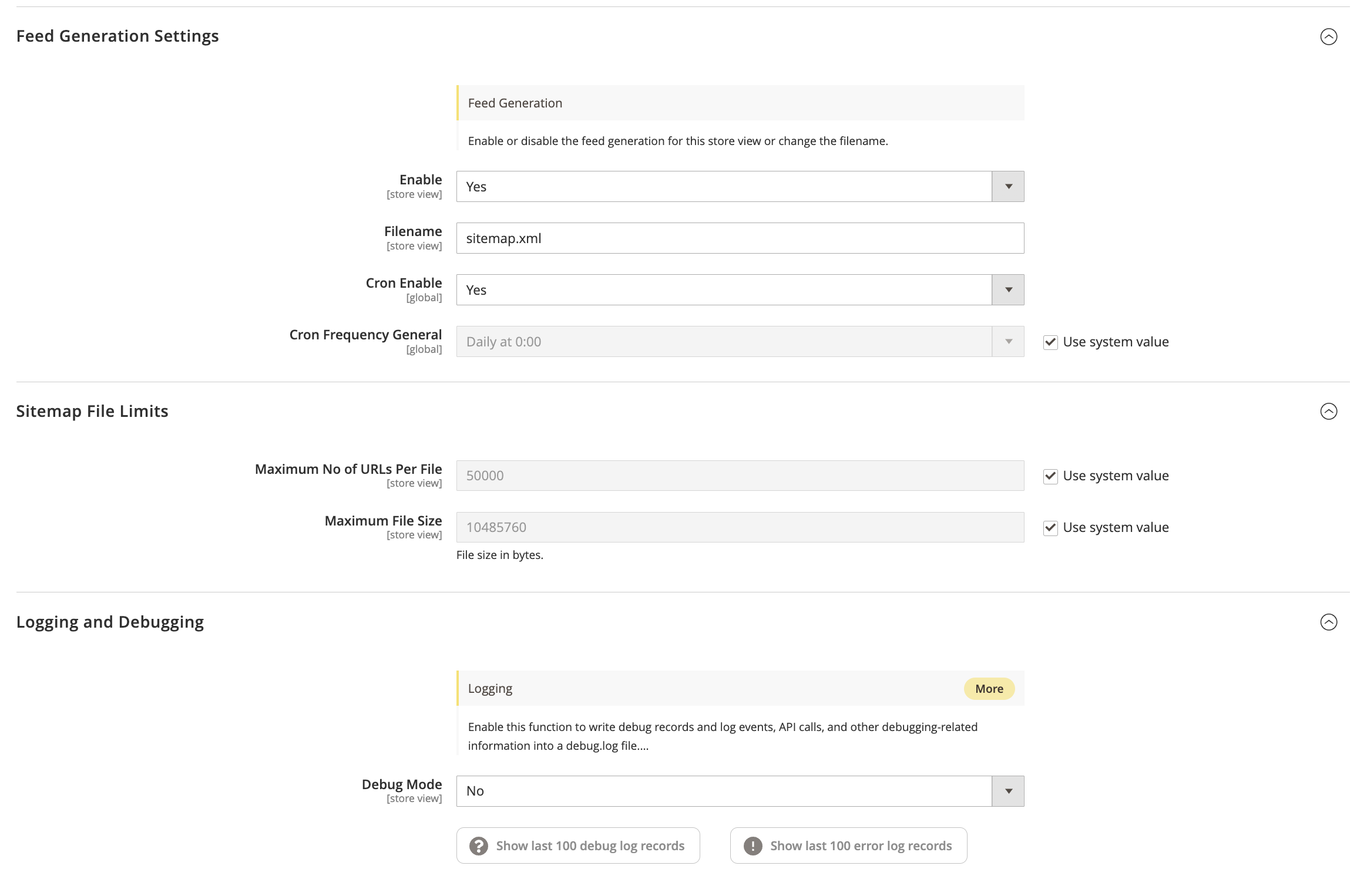Configureer de sitemap
Sitemapopties configureren in Magento 2
Instellingen voor Categorieën
- **Frequentie van categorie-updates:**Geeft aan hoe vaak categoriepagina’s naar verwachting worden gewijzigd, zodat zoekmachines weten wanneer ze opnieuw moeten worden gecrawld. Aanbevolen instelling: Stel in op dagelijks of wekelijks voor sites met regelmatige categorie-updates.
- **Categorieprioriteit:**Wijs een prioriteitsniveau toe (tussen 0.0 en 1.0) om het belang van categoriepagina’s in de sitemap aan te geven. Aanbevolen instelling: 0.5 voor algemene categorieën, verhoog deze waarde voor drukbezochte of essentiële categorieën.
- **Uitsluiten van No-Index-categorieën:**Sluit categorieën met het NOINDEX-meta-tag uit van de sitemap om verspilling van crawlcapaciteit te voorkomen en zoekmachines te focussen op relevante pagina’s. Aanbevolen instelling: Ja om onnodige of dubbele categorieën uit te sluiten.
Instellingen voor Producten
- **Frequentie van productupdates:**Geeft aan hoe vaak productpagina’s door zoekmachines moeten worden bezocht. Aanbevolen instelling: Dagelijks voor winkels met dynamische of vaak bijgewerkte voorraad.
- **Productprioriteit:**Toont het relatieve belang van productpagina’s in de sitemap met een schaal van 0.0 tot 1.0. Aanbevolen instelling: 1.0 voor bestsellers of cruciale producten.
- **Productafbeeldingen opnemen in sitemap:**Bepaalt of productafbeeldingen in de sitemap moeten worden opgenomen voor visuele zoekindexering. Opties: Alle afbeeldingen, alleen hoofdafbeeldingen, of geen. Aanbevolen instelling: Alle voor visueel georiënteerde winkels of producten.
- **Uitsluiten van No-Index-producten:**Voorkomt dat producten met een NOINDEX-tag in de sitemap worden opgenomen. Aanbevolen instelling: Ja om irrelevante of niet-beschikbare producten uit te sluiten.
Instellingen voor CMS-pagina's
- **Frequentie van CMS-pagina-updates:**Geeft aan hoe vaak CMS-pagina’s (zoals statische content of blogs) worden gewijzigd en gecrawld moeten worden. Aanbevolen instelling: Dagelijks voor contentrijke winkels.
- **CMS-pagina prioriteit:**Wijs een prioriteit toe aan CMS-pagina’s om hun belang voor zoekindexering aan te geven. Aanbevolen instelling: 0.25 voor algemene pagina’s; verhoog indien het gaat om veelbezochte of conversiegerichte pagina’s.
- **Uitsluiten van No-Index CMS-pagina's:**Zorgt ervoor dat CMS-pagina’s met NOINDEX-tag worden uitgesloten van de sitemap. Aanbevolen instelling: Ja om crawlcapaciteit te besparen op tijdelijke of minder relevante content.
Instellingen voor de Homepage-URL
- **Frequentie van homepage-updates:**Geeft aan hoe vaak de startpagina van de winkel verandert. Aanbevolen instelling: Dagelijks voor actieve winkels met vaak veranderende banners, promoties of content.
- **Prioriteit van de homepage:**Stelt het belang van de homepage in binnen de sitemap, doorgaans de hoogste prioriteit (1.0). Aanbevolen instelling: 1.0 om maximale indexeringsaandacht te verzekeren.
Best Practices
- Controleer regelmatig je sitemap-indiening in Google Search Console om crawlproblemen op te sporen.
- Stel realistische updatefrequenties in om een goede balans te vinden tussen indexering en serverbelasting.
- Sluit niet-essentiële pagina’s uit met NOINDEX om verspilling van crawlbudget te voorkomen.
Sitemapopties configureren in Magento 2
Instellingen voor Feedgeneratie
- Inschakelen: Zet het genereren van de sitemap aan of uit voor de store view. Aanbevolen instelling: Ja om automatisch je sitemap te genereren en bij te werken.
- Bestandsnaam: De naam van het gegenereerde sitemap-bestand. Standaardinstelling: sitemap.xml.
- Cron inschakelen: Automatiseer het genereren van de sitemap met behulp van Magento’s cron scheduler. Aanbevolen instelling: Ja.
- Cronfrequentie algemeen: Stel in hoe vaak de sitemap opnieuw moet worden gegenereerd. Standaard is dagelijks om 00:00.
Sitemap-bestandslimieten
- Maximaal aantal URL’s per bestand: Beperkt het aantal URL’s in een enkele sitemap. Aanbevolen instelling: De standaardinstelling van Magento van 50.000 is geschikt voor de meeste winkels.
- Maximale bestandsgrootte: Stel de maximale toegestane bestandsgrootte in voor de sitemap (in bytes). Aanbevolen instelling: De standaardwaarde (10 MB) is over het algemeen geschikt.
Logging en Debugging
- Logging: Activeert het loggen van sitemapgeneratie en eventuele fouten. Aanbevolen instelling: Alleen inschakelen tijdens het oplossen van problemen.
- Debugmodus: Activeer debugging voor gedetailleerde logboeken over sitemap-gerelateerde issues. Aanbevolen instelling: Uitgeschakeld laten in productieomgevingen om de prestaties te behouden.
Best Practices
- Controleer regelmatig je sitemap-indieningen in Google Search Console om een correcte indexering te waarborgen en mogelijke problemen op te sporen.
- Stel realistische updatefrequenties in om een goed evenwicht te bewaren tussen crawlefficiëntie en serverbelasting.
- Sluit niet-essentiële of dubbele pagina’s uit om het crawlbudget te optimaliseren en de algemene SEO-prestaties te verbeteren.
Sitemapopties configureren in Magento 2
Het gedeelte Feeds toont alle actieve feeds die beschikbaar zijn voor je winkel. Feeds zijn essentieel voor het delen van gestructureerde productgegevens, meestal met diensten zoals Google Merchant Center, zodat zoekmachines beschikken over de meest actuele informatie over je producten. Hieronder lees je hoe je dit gedeelte effectief kunt interpreteren en gebruiken.
Overzicht van Feeds
Elke feedvermelding toont de taal-specifieke feed, de bijbehorende URL, en opties om de feed te genereren, te bekijken of te downloaden. De .XML-URL is de link die je moet indienen bij externe diensten, zoals Google Merchant Center. Het is aan te raden om na het wijzigen van instellingen de feed opnieuw te downloaden om de nauwkeurigheid te garanderen.
Belangrijke Gegevens
- Feed-URL: De link naar het .XML-bestand met de productfeed. Voorbeeld: https://www.magmodules.eu/media/sitemap/sitemap-2.xml
- Feedgeneratietijd: Geeft aan hoelang het duurde om de feed te genereren en de datum van de laatste generatie. Voorbeeld: Feed gegenereerd in 0 seconde(n) op 2025-02-06 23:00:05.
- Let op: Zorg ervoor dat je je configuratiewijzigingen opslaat vóór het genereren van een nieuwe feed om inconsistenties te voorkomen.
Beschikbare Acties
Voor elke feed kun je de volgende acties uitvoeren:
- Genereren: Maak de feed opnieuw aan om recente wijzigingen in configuratie of productgegevens te verwerken. Gebruik dit na elke update.
- Voorbeeld: Bekijk een voorbeeld van de feed om de juistheid te controleren voordat je hem downloadt.
- Downloaden: Sla de feed lokaal op of dien deze in bij externe platforms zoals Google Merchant Center.
Best Practices
- Genereer feeds regelmatig opnieuw na het toevoegen of bijwerken van producten, zodat externe diensten beschikken over actuele gegevens.
- Valideer de feed met behulp van Google's tools vóór indiening om mogelijke fouten op te sporen.
- Houd een consistent schema aan voor feedgeneratie via Magento’s cronjobs om dit proces te automatiseren.



